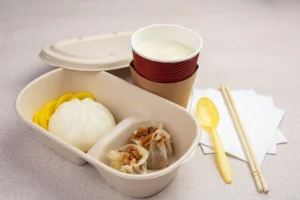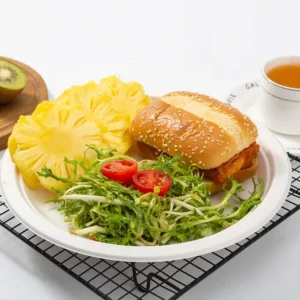Basic knowledge of biodegradable plant fiber molded products.
Question 1. What are plant fiber molded products?
Plant fiber molded products are made of plant fiber pulp (wood, bamboo, reed, succulent, grass, etc.) or recycled pulp from waste paper products as raw materials, plus professional craftsmanship and additives. , or mesh mold) on the vacuum adsorption forming a kind of three-dimensional pulp products.
Question 2. What are the application scopes of plant fiber molded products?
Food (medicine) Hardware tools, electronic products, ceramics, glass, communication equipment, computer accessories, food, medicines, cosmetics, agricultural products, instruments and meters, various small household appliances, mobile phones and accessories, etc. Packaging materials, agricultural product packaging, such as eggs, Fruits, vegetables, meat, etc., tableware, lunch boxes, spoons and forks, etc., cultural and creative products, furniture and household items, gifts, holiday items, etc.
Question 3. What are the product characteristics of plant fiber molded products?
The source of raw materials is extensive and not easy to be restricted, which meets the national environmental protection requirements and the needs of industrial development. Especially the best choice to replace plastic foam materials and PVC blister packaging materials; plant fiber molded products can be recycled and degraded. After adding special processes, they have good waterproof and oil-proof properties, and can partially replace foamed plastic products. .
Question 4. What is the thickness and weight of plant fiber molded products? Does it have anything to do with strength?
Based on the existing technology level, the thickness of paper molded products is roughly between 1mm and 5mm, and the thickness of general products is mostly maintained at about 2mm; from the current quality and application of paper molded packaging products, the maximum load-bearing load Up to 200 kg, the shape is not too complicated, and the lined packaging is the best choice for products weighing less than 50 kg; the cushioning effect of paper film packaging is mainly to use its paper wall to deform elastically when it is impacted, thereby slowing down and offsetting external forces to be realized. The elasticity of the paper mold material itself is not high, which mainly depends on the design of the support ribs of the product and the buffer cavity formed by them. The design of the support ribs plays a crucial role in the elastic deformation of the paper mold packaging products, that is, the buffer capacity. The basic basis for the design of the support ribs is the shape and use of the product itself.
With the advancement of plant fiber molding and molding technology, plant fiber molding has begun to emerge in the field of heavy product packaging.
Question 5. What are the special properties of plant fiber molded packaging products?
1. Waterproof (moisture-proof)
2. Oil proof (heat insulation)
3. Anti-static
4. Radiation protection
Question 6. What material is used for the mold making of plant fiber products? How much does it cost to make?
The mold production of plant fiber molded products is mainly made of aluminum alloy materials. The formation of paper molded products is produced by two pairs of molds (suction mold and hot pressing mold); the manufacturing cost of each mold of conventional size is about 12,000 yuan. (calculated with a template).
Plant fiber molding also uses steel molds, copper molds, resin molds, alloy molds, copper-aluminum composite molds, 3D printing molds and new material meshless molds, etc.
Question 7. What is the basis for the quotation of yellow pulp dry-pressed plant fiber products? How does it compare to the cost of bubble wrap?
The quotation of yellow pulp dry-pressed vegetable fiber molded products is based on:
1. The shape, structure, volume and weight of the product; products less than 50g are counted as 50g.
2. Raw materials used: the requirements of the manufacturing process;
4. Product output level. Comparison table of paper mold and foam packaging costs:
Question 8. What is the mold manufacturing cycle for paper molded products? What is the production cycle of paper molded products?
It takes about 7 days from mold design, mold opening to production samples;
The production can be shipped according to the order quantity within 7 days after the order is placed. According to the size of the customer's order and the daily production capacity of the product mold.
Question 9. What are the sales advantages of paper molding products?
1. According to the quality, quantity, and time proposed by the customer to deliver the goods;
2. If the customer finds defective products during production, they can be exchanged;
3. The customer will give a satisfactory solution to the reasonable requirements according to the production needs
First. Characteristics of plant fiber molded products
1. Environmental protection:
Pulp molded products are made of waste newspapers and carton paper as the main raw materials, pulped with a certain proportion of additives, dehydrated and formed through a special mold, and then subjected to a series of technological processes such as drying, heat treatment, and shaping. Pulp molded products can be recycled and degraded. After adding special technology, they have good waterproof and oil-proof properties, and can completely replace foamed plastic products, which can effectively eliminate "white pollution" and have good environmental protection.
Pulp molded products are environmentally friendly products recommended by the world's environmental protection departments. They attach great importance to environmental protection in the production process. Regarding the impact of the three wastes on environmental protection, in the entire production process, from the main raw materials used, to the entire production process. Until the end, its environmental awareness is very strong. The raw material is waste paper, and in the production and processing process, it is mainly a physical reaction. Only a small amount of chemical substances are added as water repellents. After the products are dried, basically all these chemical substances are retained in the finished product, and no environmental pollution is discharged. Pollution; the water used in the production line is used in a closed cycle, but when the product is dried, the water vapor is volatilized into the space, and there is no need to supplement water during the production process, so the water consumption is not large.
2. Cost economy:
After several years of development and innovation in pulp molding technology, the performance of equipment has been continuously improved, the production process has gradually matured, and the production cost of products has become stable. At present, the production cost of domestic paper support products is basically the same as that of foamed plastic products, and the cost of some paper support products is significantly lower than that of foamed plastic products. It is feasible to replace foam plastic shockproof products with paper support products in terms of performance and production cost. In addition to its environmental advantages, it has become an inevitable trend for pulp molded products to replace foam plastic products.
Second. Pulping process of plant fiber molded molded products
Using virgin cardboard, waste paper, cartons, etc. as raw materials, through pulping, refining and other processes, the paper is turned into fibers, which are suspended in water to form pulp. According to the characteristics of the products to be produced, the fiber length and pulp concentration can be appropriately controlled to meet the needs of the products. Adding special additives to the pulp can make the product waterproof and oil-proof. By adding appropriate pigments, the product can have a variety of colors.
Third. The molding process of pulp molding products
At present, there are two types of foreign pulp molding production equipment: vacuum forming method and grouting method.
1. Vacuum suction forming method is the most popular method for paper and plastic products. According to its different structure, there are three ways: drum type, flip type, reciprocating lift type
Rotary drum type: continuous rotary production, high production efficiency, large investment in molds, high mold processing accuracy, high technical requirements for equipment processing accuracy, one set of concave molds and eight sets of punch molds, need to use CNC center to process molds, long processing cycle, Big investment. Because it is continuous production, it is suitable for mass production of stereotyped products, such as plates, dinner plates, wine trays, and egg trays. For industrial molding production, it is not applicable due to non-standard, small quantity and batch, and large mold investment.
Rotation type: The rotary type production is less efficient than the drum type production. It is suitable for medium batch and non-standard production of industrial molding. However, because it is a set of concave molds and two sets of punches, it is necessary to use a CNC center to process the molds, and the mold investment is large. , the cycle is long.
Round-trip lift type: The production efficiency is lower than that of the drum type, and it is not much different from the rotary type. It is a commonly used equipment at present. Because this equipment only needs one set of concave molds and one set of punches, it does not need CNC center processing, especially It is suitable for non-standard, small batch and fast cycle industrial packaging products (the mold production cycle of industrial packaging products is usually within 10 days).
2. grouting method
The injection molding method is to calculate the required amount of slurry (material) according to different pulp packaging products, and quantitatively inject it into the molding cavity for adsorption molding. This molding method is suitable for standard products with little change and stereotypes. It is often used in tableware molding products. Due to the difficulty in grasping the calculation of stereotypes, this molding method is not used in non-standard paper-plastic packaging (industrial packaging).
Fourth, the drying process of plant fiber molded products
After pulping and molding, pulp products generally contain high water content and need to go through a drying process. The drying process uses fuel (gas), electricity or steam, hot oil or other media as heat sources to heat the air to dry the molded pulp products in hot air (180~220°C), and use a fan to extract the products and evaporate them. moisture for fast drying.
Fifth, plant fiber molding products shaping process
After the pulp product is formed and dried, it is basically shaped, and then pressed with high temperature and high pressure to make its appearance neat and beautiful, achieve better toughness and better shock resistance. In the shaping process, the heating plate is generally heated by electric heating or other heat medium (such as heat transfer oil) is used to heat the heating plate, so that the pulp product mold has a higher temperature and achieves a rapid shaping effect.
Sixth, pulp molding products shaping process
After the pulp product is formed and dried, it is basically shaped, and then pressed with high temperature and high pressure to make its appearance neat and beautiful, achieve better toughness and better shock resistance. In the shaping process, the heating plate is generally heated by electric heating or other heat medium (such as heat transfer oil) is used to heat the heating plate, so that the pulp product mold has a higher temperature and achieves a rapid shaping effect.







